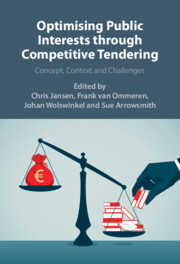Book contents
- Optimising Public Interests through Competitive Tendering
- Optimising Public Interests through Competitive Tendering
- Copyright page
- Contents
- Contributors
- Preface
- Table of Cases
- Abbreviations
- 1 Optimising Public Interests through Competitive Tendering
- Part I Characterising Limited Rights
- 2 Public Procurement
- 3 Licensing
- 4 Subsidising
- 5 Government Sales and Privatisations
- Part II Connecting Limited Rights
3 - Licensing
from Part I - Characterising Limited Rights
Published online by Cambridge University Press: 11 April 2025
- Optimising Public Interests through Competitive Tendering
- Optimising Public Interests through Competitive Tendering
- Copyright page
- Contents
- Contributors
- Preface
- Table of Cases
- Abbreviations
- 1 Optimising Public Interests through Competitive Tendering
- Part I Characterising Limited Rights
- 2 Public Procurement
- 3 Licensing
- 4 Subsidising
- 5 Government Sales and Privatisations
- Part II Connecting Limited Rights
Summary
This chapter addresses the question of whether and how public interests are optimised by competitive tendering when allocating limited licences. Licence requirements apply inter alia to telecommunication frequencies, slots, concessions for public transport (taxi) or emergency rescue services, gambling or using natural resources, CO2 emission rights, places at universities, trade fairs or markets. The number of available licences is often limited owing to scarcity of natural resources, state-imposed quantitative restrictions or limited demand or supply. Despite the variety of sectors, all allocation regimes are subject to comprehensive principle-based regulation since EU and national constitutional law formulate substantive and procedural standards for allocating scarce licences. Standards and concretisations may also be found in legislation at the national and EU levels. Against this background, the chapter explores the choices which the legislature has made, or not made, in terms of competitive tendering, and of defining its modalities. Which balance of interests do these choices reflect? Have competing interests been optimised? Moreover, which legal and notably constitutional standards determine these choices regarding optimising public interests, notably in view of creating scarcity, inviting applications versus direct awards and defining allocation criteria and procedures?
Keywords
- Type
- Chapter
- Information
- Optimizing Public Interests through Competitive TenderingConcept, Context and Challenges, pp. 121 - 162Publisher: Cambridge University PressPrint publication year: 2025

